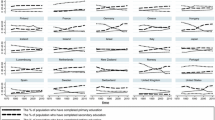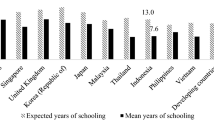Abstract
The study estimates the impact of human capital on growth by focusing on three countries which differ in the human capital’s structure and quality: the Czech Republic, Estonia and Bulgaria. Human capital is measured by the labor force having completed at least upper secondary education. The co-integrating regressions based on the neoclassical production function are solved by the DOLS method with structural breaks. The results do not support the hypothesis that higher educational attainment per se accelerates aggregate output since the countries differ in both the sign and magnitude of the regression coefficients. However, the findings justify the view that the role of tertiary education increases with the level of economic development. One plausible explanation of this outcome is that the quality of human capital is more important for growth than its quantity. With regard to that, the paper provides evidence that in the European economies the foreign language learning used as a measure of the quality of schooling is more strongly linked to the increments of real GDP per capita than educational attainment. The impact of higher education might be explained also in light of the labor market channel, specifically the deepening qualification mismatch in countries with rising tertiary education graduation rates.



Similar content being viewed by others
Notes
The abbreviation NMS-10 (New Member States) represents the group of post-communist EU members comprising Bulgaria, the Czech Republic, Estonia, Hungary, Latvia, Lithuania, Poland, Romania, Slovakia and Slovenia. Croatia is excluded from the analysis due to incomplete data sets. The data on educational attainment presented in this paragraph refer to the average values over the investigated period (2000–2013).
The papers on CEE focus primarily on the role of FDI (see, for example, the meta-analysis of Iwasaki and Tokunaga 2014).
The marginal productivity of capital (MPH) is linked to its elasticity (β) and its share in aggregate output as follows:
The source of data is Eurostat.
The additional indicators related to pupils learning French or those who don’t learn any foreign languages do not produce robust results.
It should be noted that the composition of the two groups is not exactly the same. For example, some people leave school earlier while others, usually the most educated population in the NMS, go to study or work abroad. However, these differences are not so big as to change the cross-country regression estimates significantly.
References
Ang, J., Madsen, J., Rabiul, M.: The effects of human capital composition on technological convergence. J Macroecon. 33, 465–476 (2011)
Barro, R., Lee, J.-W.: A new data set of educational attainment in the world, 1950–2010. J. Dev. Econ. 104, 184–198 (2010)
Becker, G.: Human capital: a theoretical and empirical analysis with special reference to education, 3rd edn. The University of Chicago Press, Chicago (1994)
Birk, A.: Qualification-mismatch and long-term unemployment in a growth-matching model, HWWA Discussion Paper, No. 128 (2001)
Breton, T.: The quality vs. the quantity of schooling: What drives economic growth? Econ. Educ. Rev. 30, 765–773 (2011)
Brodzicki, T.: Augmented Solow model with Mincerian education and transport infrastructure externalities. Czech Econ. Rev. 6, 155–170 (2012)
Budria, S., Moro-Egido, A.: Education, educational mismatch, and wage inequality: evidence from Spain. Econ. Educ. Rev. 27, 332–341 (2008)
Carrion-i-Silvestre, J., Sansó, A.: Testing the null of cointegration with structural breaks. Oxford B Econ. Stat. 68, 623–646 (2006)
Castelló-Climent, A., Hidalgo-Cabrillana, A.: The role of educational quality and quantity in the process of economic development. Econ. Educ. Rev. 31, 391–409 (2012)
Dowrick, S.: Ideas and education: level or growth effects? WP 9709, NBER (2003)
Engle, R., Granger, C.: Co-integration and error correction: Representation, Estimation and Testing. Econom. 55, 251–276 (1987)
Faruq, H., Taylor, A.C.: Quality of education, economic performance and institutional environment. Int. Adv. Econ. Res. 17, 224–235 (2011)
Földvári, P., Van Leeuwen, B.: Capital accumulation and growth in Central Europe, 1920–2006. Eastern Euro. Econ. 51, 69–93 (2013)
Ganeva, R., Ganev, K. (eds.): A forecasting model for labor market developments and future needs for knowledge and skills in Bulgaria in the medium and long-trem. Smart, Sofia (2014)
Gerunov, A.: Connection between financial sector and economic growth at high levels of financial development. Econ. Stud. 2, 39–68 (2014)
Godoy, R., Reyes-Garcia, V., Seyfred, C., et al.: Language skills and earnings: evidence from pre-industrial economy in the Bolivian Amazon. Econ. Educ. Rev. 26, 349–360 (2007)
Gregory, A.W., Hansen, B.E.: Tests for Cointegration in Models with regime and trend shifts. Oxford B Econ. Stat. 58, 555–560 (1996)
Hall, M., Farkas, G.: Does human capital raise earnings for immigrants in the low-skill labor market? Demography 45, 619–639 (2008)
Hagan, J., Lowe, N., Quingla, C.: Skills on the move: rethinking the relationship between human capital and immigrant economic mobility. Work Occup. 38, 149–178 (2011)
Hanushek, E., Kimko, D.: Schooling, labor-force quality, and the growth of nations. Am. Econ. Rev. 90, 1184–1208 (2000)
Hanushek E., Woessman L.: The Role of Education Quality for Economic Growth. World Bank, WP 4122 (2007)
Iwasaki, I., Tokunaga, M.: Macroeconomic impacts of FDI in transition economies: a meta-analysis. World Devel. 61, 53–69 (2014)
Jin, J.C., Jin, L.: On the relationship between university education and economic growth: the role of professors’ publication. Educ. Econ. 22, 635–651 (2014)
Johansen, S., Mosconi, R., Nielsen, B.: Cointegraton analysis in the presence of structural breaks in the deterministic trend. Econ. J. 3, 216–249 (2000)
Jones, G.: Cognitive and technology diffusion: an empirical test. Econ. Syst. 36, 444–460 (2000)
Katircioglu, S., Fethi, S., Caner, H.: Testing the higher education-led growth hypothesis in a small island: an empirical investigation from a new version of the Solow growth model. Qual. Quant. 48, 729–744 (2014)
Kim, J., Park, J.: FDI and country-specific human capital. Econ. Inq. 51, 198–210 (2013)
Kogan, I., Gebel, M., Noelke, C.: Educational systems and inequalities in educational attainment in central and eastern european countries. Stud. Transit. States Soc. 4, 69–83 (2012)
Kurozumi, E.: Testing for stationarity with a break. J. Econ. 108, 63–99 (2002)
Kwiatkowski, D., Phillips, P., Schmidt, P., Shin, Y.: Testing the null hypothesis of stationarity against the alternative of a unit root. J. Econ. 54, 159–178 (1992)
Lanne, M., Lytkepohl, H., Saikkonen, P.: Comparison of unit root tests for time series with level shifts. J. Time Ser. Anal. 23, 667–685 (2002)
Lucas, R.: On the mechanism of economic development. J. Monet. Econ. 22, 3–42 (1988)
Mankiw, G., Romer, D., Weil, D.: A contribution to the empirics of economic growth. Quart. J. Econ. 107, 407–437 (1992)
McGowan, A., Andrews, D.: Labor market mismatch and labor productivity: evidence from PIAAC data. OECD Economics department working papers, N. 1209, OECD publishing, Paris (2015)
McMahon, W.: Education and growth in East Asia. Econ. Educ. Rev. 17, 159–172 (1998)
Morgado, A., Sequeira, T.N., Santos, M., et al.: Measuring labour mismatch in Europe, CEFAGE-UE WP 13. University of Evora, Portugal (2014)
Musai, M., Mehrara, M., Fakhr, S.: Relationship between education and economic growth (international comparison). Eur. J. Econ. Finance Adm. Sci. 29, 26–32 (2011)
Neycheva, M.: Does public expenditure on education matter for growth in Europe? A comparison between old EU member states and post-communist economies. Post-Commun. Econ. 22, 141–164 (2010)
Nonneman, W., Vanhoudt, P.: A further augmentation of the Solow model and the empirics of economic growth for OECD countries. Q J Econ. 111, 943–953 (1996)
Oh, C., Selmier, W., Lien, D.: International trade, foreign direct investment and transaction costs in languages. J. Soc. Econ. 40, 732–735 (2011)
Paradiso, A., Kumar, S., Rao, B.: The growth effects of education in Australia. Appl. Econ. 45, 3843–3852 (2013)
Pereira, J., Aubyn, M.: What level of education matters most for growth? C from Portugal. Econ. Educ. Rev. 28, 67–73 (2008)
Perron, P.: The great crash, the oil price shock, and the unit root hypothesis. Econometrica 57, 1361–1401 (1989)
Petrakis, P.E., Stamatakis, D.: Growth and Educational Levels: a comparative analysis. Econ. Educ. Rev. 21, 513–521 (2002)
Próchniak, M.: Determinants of economic growth in Central and Eastern Europe: the global crisis perspective. Post-Commun. Econ. 23, 449–468 (2011)
Rogers, M.: Directly unproductive schooling: how country characteristics affect the impact of schooling on growth. Euro. Econ. Rev. 52, 356–385 (2008)
Romer, P.: Increasing returns and long-run growth. J. Polit. Econ. 94, 1002–1037 (1986)
Rusinova, D.: Growth in transition: reexamining the role of factor inputs and geography. Econ. Syst. 31, 232–255 (2007)
Saikkonen, P., Lyutkepohl, H.: Testing for a unit root in a time series with a level shift at unknown time. Econ. Theory 18, 313–348 (2002)
Smetkowski, M.: Regional disparities in Central and Eastern European Countries: trends, drivers and prospects. Europe-Asia Stud. 65, 1529–1554 (2013)
Soukiazis, E., Antunes, M.: Is foreign trade important for regional growth? Empirical evidence from Portugal. Econ. Modell. 28, 1363–1373 (2011)
Spagat, M.: Human capital and the future of transition economies. J. Comp. Econ. 34, 34–56 (2006)
Stock, J., Watson, M.: A simple estimator of cointegrating vectors in higher order integrated systems. Econometrica 61, 783–820 (1993)
Tyler, W.: Growth and export expansion in developing countries. J. Dev. Econ. 9, 121–130 (1981)
Van Leeuwen, B., Földvári, P.: How much human capital does Eastern Europe have? Post-Commun. Econ. 20, 189–201 (2008)
Vandenbussche, J., Aghion, P., Meghir, C.: Growth, distance to frontier and composition of human capital. J. Econ. Growth 11, 97–127 (2006)
Verbič, M., Majcen, B., Čok, M.: Education and economic growth in Slovenia: a dynamic general equilibrium approach with endogenous growth. Ekon. Cas. 62, 19–45 (2014)
Yamamoto, T.: A simple approach to the statistical inference in linear time series models which may have some unit roots. Hitotsubashi J. Econ. 37, 87–100 (1996)
Zivot, E., Andrews, D.: Further evidence on the great crash, the oil-price shock, and the unit-root hypothesis. J. Bus. Econ. Statist. 10, 251–270 (1992)
Acknowledgments
I would like to to express my gratitude to the Editor as well as two anonymous Reviewers for their helpful comments.
Author information
Authors and Affiliations
Corresponding author
Appendix
Rights and permissions
About this article
Cite this article
Neycheva, M. Secondary versus higher education for growth: the case of three countries with different human capital’s structure and quality. Qual Quant 50, 2367–2393 (2016). https://doi.org/10.1007/s11135-015-0267-0
Published:
Issue Date:
DOI: https://doi.org/10.1007/s11135-015-0267-0




